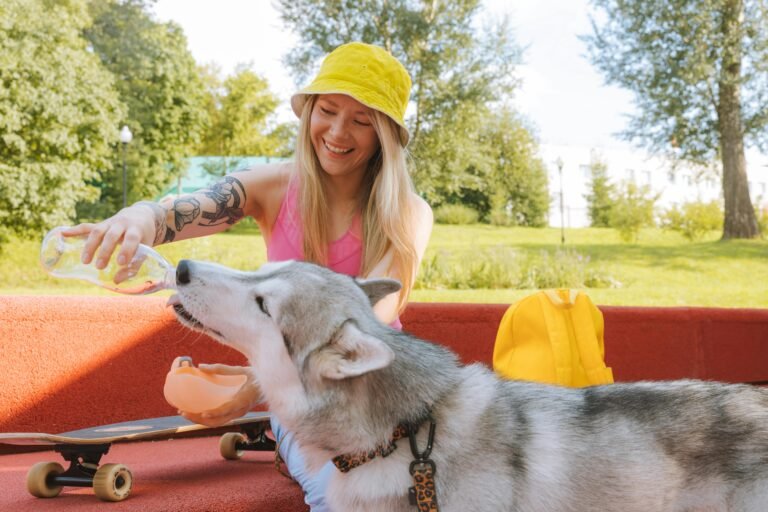Understanding Dog Emotions
Dogs, often referred to as man’s best friend, possess a complex emotional landscape that, while different from humans, demonstrates significant parallels. Research indicates that dogs experience a spectrum of emotions that can be likened to feelings such as happiness, fear, and anxiety. At the biological level, these emotions are influenced by the release of hormones, such as oxytocin and cortisol, which play crucial roles in bonding and stress responses. This hormonal activity not only shapes how dogs feel but also informs how they express those feelings.
In terms of emotional expression, dogs are adept at communicating their feelings through their body language and facial cues. When a dog is joyful, it may exhibit behaviors such as wagging its tail and maintaining a relaxed body posture. Conversely, when a dog feels threatened or scared, its body language can include lowered ears, a tucked tail, and avoidance behaviors, which are all vital signals to observe. Understanding these cues is essential for dog owners, as they can help interpret a dog’s emotional state and respond appropriately.
Additionally, anxiety can manifest in various ways, such as excessive barking or destructive behaviors. Dogs may develop these reactions due to environmental factors or past experiences, emphasizing the need for awareness among pet owners. By recognizing and addressing their emotional needs, owners can foster a more harmonious relationship with their dogs. It’s also important to note that, similar to humans, every dog is unique, and their emotional expressions can vary widely based on individual personality traits and experiences.
Thus, the emotional lives of dogs are intricate and worthy of consideration, as these feelings guide their interactions with both humans and their environment. Understanding dog emotions enhances the human-animal bond, allowing both parties to communicate more effectively.
Recognizing a Dog’s Smile
Interpreting a dog’s smile involves a careful examination of various facial features and body language. The most prominent indicator is the position of the mouth. When a dog is exhibiting a smile, its mouth may be slightly open and relaxed, often revealing the tongue in a playful manner. This relaxed jaw position is often accompanied by a gentle expression that invites interaction.
Another essential element to consider is the dog’s eyes. A genuinely happy dog often displays soft, relaxed eyes that may appear slightly squinted. In contrast, eyes that seem tense or wide open can indicate stress or discomfort rather than joy. It is also helpful to observe the brightness of the dog’s eyes; a bright, engaged gaze can suggest contentment, often characterizing a dog’s smile.
The positioning of the ears is another indicator of a dog’s emotional state. Ears that are held in a relaxed position or even flopped down can suggest a happy demeanor, whereas erect or pinned-back ears may indicate tension or unease. Overall posture plays a critical role as well; a smiling dog often exhibits a relaxed body stance, perhaps leaning slightly forward or wagging its tail energetically. Tail wagging, particularly when it involves the whole body, signifies excitement and happiness, further reinforcing the presence of a smile.
It is also pivotal to interpret these signs within the context of the dog’s individual personality. Each dog has its own unique way of expressing happiness, shaped by its breed, past experiences, and environment. For example, some dogs may exhibit broad smiles, while others might express happiness more subtly. Paying close attention to the overall situation and the individual dog’s personality will lead to a more accurate understanding of whether a dog is truly smiling or simply displaying another form of emotional expression.
Common Misinterpretations of Dog Facial Expressions
Understanding canine communication is essential for any dog owner. Unfortunately, many individuals misinterpret their dogs’ facial expressions, particularly when it comes to what might be perceived as a “smile.” Often, a dog’s relaxed face or open mouth may be mistaken for happiness or a smile. However, this expression can be associated with different emotional states, including submission or discomfort. For example, a dog may appear to be smiling when it is, in fact, exhibiting a submissive demeanor, trying to appease a more dominant individual, whether that is another dog or even a human.
Similarly, some dogs display a “smile” when they are nervous or anxious. The relaxation of the jaw may lead observers to believe the dog is content, while the underlying emotion is quite the opposite. Body language plays a crucial role in accurately reading a dog’s feelings. It is important to consider accompanying signals, such as tail position and overall body posture, to better understand the nuances of a dog’s expression. For instance, a dog with a high and stiff tail, along with a mouth that appears relaxed, might still be feeling stressed despite the outward appearance of a smile.
Another common misconception arises from the presence of a dog’s exposed teeth. Many people interpret this gesture as a sign of friendliness. However, bared teeth can often indicate discomfort, aggression, or fear, particularly when displayed alongside a rigid body and lowered ears. Learning to observe these subtle cues enhances a dog owner’s ability to discern genuine expressions of joy versus those stemming from less favorable emotions. By educating themselves on these nuances, dog owners can create a more harmonious relationship with their pets and avoid potential misunderstandings that could lead to mishandling.
Strengthening the Bond through Understanding
Developing a strong bond with your dog requires a nuanced understanding of their emotions, specifically through their facial expressions and body language. Observing your dog’s behavior in various situations can yield invaluable insights into their emotional state. For instance, when a dog appears relaxed with soft eyes and a loose body posture, they are likely content and happy. Conversely, a tense body and a growl may indicate fear or discomfort. By recognizing these signals, dog owners can respond appropriately, reinforcing positive behavior and addressing distress in their pets.
Engaging in positive reinforcement training is a significant method for enhancing the relationship between an owner and their dog. This training method involves rewarding desirable behaviors with treats, praise, or playtime, thereby building trust and affection. When dogs realize that their actions lead to positive outcomes, they are more likely to engage with their owners and express pleasure through wagging tails or playful interactions. This not only strengthens the bond but also encourages open communication between you and your dog.
Non-verbal communication plays a crucial role in understanding your dog’s feelings. Dogs are inherently attentive to human body language, so mirroring calm and relaxed postures can help convey a sense of safety. Additionally, maintaining appropriate eye contact signals to your dog that you are listening and engaged. Creating an environment where your dog feels safe to express their emotions openly is essential. Ensure that your home is a comfortable space, free from stressors, where your dog can showcase their emotions, whether it be joy or apprehension. By fostering this environment, you cultivate a trusting relationship that allows both you and your dog to thrive together.






